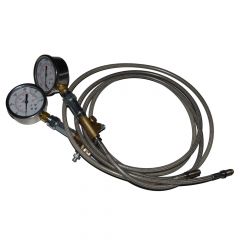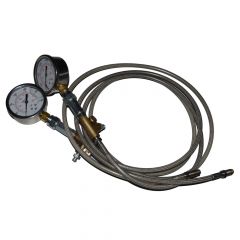How to test the pressure in the hydraulic system of the Silver Shadow and Bentley T models
System Depressurisation
Either of the two following methods may be employed to de-pressurise the systems but generally it will be found that the first is the more convenient.
Method 1
Switch on the ignition with the gearchange selector in Neutral or a car door open (fast height control conditions) but do not start the engine, then pump the brake pedal 50 or 60 times until both hydraulic warning lamps on the instrument panel are illuminated and remain illuminated.
De-pressurise the height control rams by placing a bleed tube on each ram bleed screw in turn, opening the screws and bleeding off the fluid into a clean container. After each ram has been de-pressurised the bleed screw must be tightened up and the reservoir topped up to replace the fluid that bled off. If the work on the system requires the removal of hydraulic pipes or components, disconnect the battery which is located in the boot.
Method 2
With the ignition switched off, place a length of bleed tube over the bleed screw in the accumulator valve body and hold the free end immersed in RR363 in a clean container. Open the bleed screw slightly and bleed until fluid no longer flows from the accumulator. The bleed screw should only be opened fractionally otherwise the accumulator pressure will force the tube off the bleed screw. Close the bleed screw, remove the tube and repeat the operation for the other accumulator. Repeat the procedure for evacuating the height control rams, as given under Method 1.
1. After depressurising both hydraulic systems, remove the high pressure pipes from the front and rear accumulator valve bodies and then connect the gauges.
2. When the test kit has been connected, run the car to carry out the the test.
3. In the accumulators, there is 1000Ibs of nitrogen. When you start the car, you should see the flick up pressure read 1000psi which indicates that the accumulators are fully charged. In this example, the flick up pressure is correct.
4. You will now see the gauges rising which indicates the brake pumps are working and should settle at around 2400-2500psi. On the test rig, our reconditioned units are tested at 2500psi however on the car 2200psi is permissible.
5. However in this test example, although the pressure readings are lower than 2000psi, there are no warning lights or pressure related issues.
6. After the test is complete, use the bleed nipple on the test kit to release the pressure in the system and reconnect the high pressure pipes to the valve bodies.


